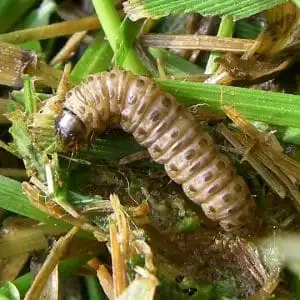Named for the webbed network of tunnels it makes, the sod webworm (Crambus) is not a worm at all, but the larvae of a small moth. As a moth it doesn’t do any harm, but during the larval stage this pest loves to devour cool-season grasses, like Kentucky bluegrass, and can destroy a lawn. A native to the United States, the sod webworm was not imported like other invasive creatures. Although found in most lawns, these creatures are not a problem until the population gets out of control or your lawn is less than healthy.
Identifying Sod Webworms
Growing to approximately an inch in size, sod webworms are gray or tan in color with a brown head and dark round spots on the body. These caterpillar-like creatures feed on grass just above the soil or thatch line and store uneaten blades in their silky tunnels.
As adults, the small lawn moths are tan or light brown in color and sometimes have mottled patterns on their wings. Although they are about a half-inch long in size, the wingspan can be double that. They have long, snout-like protuberances on the front of the head. The moths remain hidden in the grass during the day. They achieve this by resting vertically in the grass and folding wings under bodies to create a profile as slim as the blade of grass on which they sit.
Sod Webworm Signs and Symptoms
The earliest signs of sod webworms show up in spring, but the most damage occurs later in the summer. Grass thins and has a cropped appearance. Eventually, irregular yellowish or brown patches develop. These areas grow in size and connect if the infestation goes unchecked.
Sod caterpillars create silky white tunnels throughout the thatch layer of the turf. They emerge at night to feed on the grass, often leaving behind tiny green pellets (fecal matter or frass) near the opening of the tunnels.
Sod Webworm Management
Because sod webworms live in thatch, keep this layer of your lawn to a minimum by aerating or raking. A little thatch is good, but too much makes it easy for them to thrive. Trim back trees and shrubs and let the sun shine in on your yard. These pests rarely feast in shaded areas.
The sod webworm larvae is a tasty meal for many predators like birds and certain insects. Beneficial nematodes feed on these pests, as well as others, and can be purchased at some garden centers.
If nematodes are not your thing, mix up a concoction of two tablespoons of dish soap and two gallons of water. Pour the mixture on infected areas of the lawn and watch the critters rise to the top to be raked away and destroyed.
If this does not work, you may have to go the chemical route. Ask an expert or someone at your local garden center for a pesticide that is effective on sod webworms. It usually takes a minimum of two applications, which should be applied late afternoon or early evening when the pests are about to feed.
Prevention
Like with most pests, diseases, and weeds, a strong healthy lawn is the best defense against sod webworms. Maintain your lawn with regular mowing, fertilizing, and watering, plus reseed bare or thinned areas. A thick lush lawn is no place for a pest.
Keep in mind that spotting moths in your yard does not necessarily mean you have a sod webworm infestation. It’s best to call in an expert to figure out what’s ailing your lawn. Contact Free Spray Lawn Care today at 419-529-5296 and let us help you keep unwanted pests from turning your turf into a mess.



Comments (0)
Thanks for your comment!
Thanks for your feedback! Your comments have been successfully submitted! Please note, all comments require admin approval prior to display.
Error submitting comment!
There is a problem with your comment, please see below and try again.